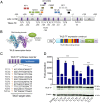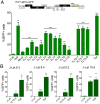Reactivation of Latent HIV-1 Expression by Engineered TALE Transcription Factors
- PMID: 26933881
- PMCID: PMC4774903
- DOI: 10.1371/journal.pone.0150037
Reactivation of Latent HIV-1 Expression by Engineered TALE Transcription Factors
Abstract
The presence of replication-competent HIV-1 -which resides mainly in resting CD4+ T cells--is a major hurdle to its eradication. While pharmacological approaches have been useful for inducing the expression of this latent population of virus, they have been unable to purge HIV-1 from all its reservoirs. Additionally, many of these strategies have been associated with adverse effects, underscoring the need for alternative approaches capable of reactivating viral expression. Here we show that engineered transcriptional modulators based on customizable transcription activator-like effector (TALE) proteins can induce gene expression from the HIV-1 long terminal repeat promoter, and that combinations of TALE transcription factors can synergistically reactivate latent viral expression in cell line models of HIV-1 latency. We further show that complementing TALE transcription factors with Vorinostat, a histone deacetylase inhibitor, enhances HIV-1 expression in latency models. Collectively, these findings demonstrate that TALE transcription factors are a potentially effective alternative to current pharmacological routes for reactivating latent virus and that combining synthetic transcriptional activators with histone deacetylase inhibitors could lead to the development of improved therapies for latent HIV-1 infection.
Conflict of interest statement
Figures




Similar articles
-
The histone deacetylase inhibitor vorinostat (SAHA) increases the susceptibility of uninfected CD4+ T cells to HIV by increasing the kinetics and efficiency of postentry viral events.J Virol. 2014 Sep;88(18):10803-12. doi: 10.1128/JVI.00320-14. Epub 2014 Jul 9. J Virol. 2014. PMID: 25008921 Free PMC article.
-
Short Communication: The Broad-Spectrum Histone Deacetylase Inhibitors Vorinostat and Panobinostat Activate Latent HIV in CD4(+) T Cells In Part Through Phosphorylation of the T-Loop of the CDK9 Subunit of P-TEFb.AIDS Res Hum Retroviruses. 2016 Feb;32(2):169-73. doi: 10.1089/AID.2015.0347. AIDS Res Hum Retroviruses. 2016. PMID: 26727990 Free PMC article.
-
Stimulating the RIG-I pathway to kill cells in the latent HIV reservoir following viral reactivation.Nat Med. 2016 Jul;22(7):807-11. doi: 10.1038/nm.4124. Epub 2016 Jun 13. Nat Med. 2016. PMID: 27294875 Free PMC article.
-
CXCR4 Targeting Nanoplatform for Transcriptional Activation of Latent HIV-1 Infected T Cells.ACS Appl Bio Mater. 2024 Aug 19;7(8):4831-4842. doi: 10.1021/acsabm.3c00456. Epub 2023 Aug 16. ACS Appl Bio Mater. 2024. PMID: 37586084 Review.
-
Therapy for latent HIV-1 infection: the role of histone deacetylase inhibitors.Antivir Chem Chemother. 2014 Jan 29;23(4):145-9. doi: 10.3851/IMP2551. Antivir Chem Chemother. 2014. PMID: 24318952 Free PMC article. Review.
Cited by
-
Targeted HIV-1 Latency Reversal Using CRISPR/Cas9-Derived Transcriptional Activator Systems.PLoS One. 2016 Jun 24;11(6):e0158294. doi: 10.1371/journal.pone.0158294. eCollection 2016. PLoS One. 2016. PMID: 27341108 Free PMC article.
-
Intestinal CD4 Depletion in HIV / SIV Infection.Curr Immunol Rev. 2019;15(1):76-91. doi: 10.2174/1573395514666180605083448. Curr Immunol Rev. 2019. PMID: 31431807 Free PMC article.
-
Strategies to eradicate HIV from infected patients: elimination of latent provirus reservoirs.Cell Mol Life Sci. 2019 Sep;76(18):3583-3600. doi: 10.1007/s00018-019-03156-8. Epub 2019 May 25. Cell Mol Life Sci. 2019. PMID: 31129856 Free PMC article. Review.
-
Genome-Editing Technologies: Principles and Applications.Cold Spring Harb Perspect Biol. 2016 Dec 1;8(12):a023754. doi: 10.1101/cshperspect.a023754. Cold Spring Harb Perspect Biol. 2016. PMID: 27908936 Free PMC article. Review.
-
Inhibition of HIV replication through siRNA carried by CXCR4-targeted chimeric nanobody.Cell Mol Life Sci. 2020 Jul;77(14):2859-2870. doi: 10.1007/s00018-019-03334-8. Epub 2019 Oct 22. Cell Mol Life Sci. 2020. PMID: 31641784 Free PMC article.
References
-
- Hammer SM, Katzenstein DA, Hughes MD, Gundacker H, Schooley RT, Haubrich RH, et al. A Trial Comparing Nucleoside Monotherapy with Combination Therapy in HIV-Infected Adults with CD4 Cell Counts from 200 to 500 per Cubic Millimeter. New England Journal of Medicine. 1996. pp. 1081–1090. - PubMed
-
- Perelson AS, Essunger P, Cao Y, Vesanen M, Hurley A, Saksela K, et al. Decay characteristics of HIV-1-infected compartments during combination therapy. Nature. 1997;387: 188–191. - PubMed
-
- Gulick RM, Mellors JW, Havlir D, Eron JJ, Gonzalez C, McMahon D, et al. Treatment with indinavir, zidovudine, and lamivudine in adults with human immunodeficiency virus infection and prior antiretroviral therapy. The New England journal of medicine. 1997. - PubMed
-
- Chun TW, Davey RT, Engel D, Lane HC, Fauci AS. Re-emergence of HIV after stopping therapy. Nature. 1999;401: 874–875. - PubMed
Publication types
MeSH terms
Substances
Grants and funding
LinkOut - more resources
Full Text Sources
Other Literature Sources
Medical
Research Materials

